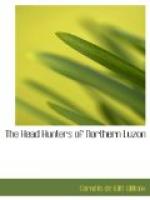I was disgusted, and still more disconcerted, this afternoon, to find my pony going badly. He was perfectly willing to walk, but at a most dignified rate, selected by himself. He apparently had no objection to catching up the party every now and then, but only to relapse into his funeral walk, after contact had been re-established. But then Cootes took the lead that afternoon, and as his thoroughbred had had two days’ rest, and breasted all the rises with apparent joyousness, nobody was able to keep up, until Mr. Worcester took the head with his black, a powerful but reasonable animal. However, everybody gets into camp sooner or later, and so did we all at a resting-point called Nozo, where we all turned in after supper, for reveille was to be at three o’clock. This had been a great day of contrasts in a descending scale, from motors, electric lights, and telephones in the morning to our solitary camp in the mountains at night, surrounded by watch-fires and guarded by Constabulary sentinels. This, by the way, was the only time we were so guarded.
CHAPTER IV
Early start.—Pine forest.—Vegetation.—Rest at Amugan.—The gansa.—Bone.
We set out next morning at five-thirty. Our journey so far, that is, since we mounted, had taken us over a preliminary range, and now we began a more serious climb. The morning was delightfully fresh and cool, with promise of a fine blazing sun later. Far ahead and above us on the skyline, we could see a cut in the forest where our trail crossed the divide. But that was miles away, and in the meantime we were ascending a lovely valley, pines, grass, and bright red soil. It was delicious that morning, riding under the pines.
“Pinea brachia cum trepidant,
Audio canticulum zephyri!”
And part of the pleasure was due to the fact that we had an unobstructed view in all directions, usually not the case in the tropical forest. At one point we had a full view of Arayat, at another of Santo Tomas, near which we had passed yesterday on coming down from Baguio. But fine as were the distant views we got from time to time, the great attraction was the country itself, through which we were passing. Barring the total absence of any sign of man, it might have been taken for Japan, in the neighborhood of Miyanoshita, without, however, any trace of Japanese atmosphere.
The valley was steep-walled, narrow and twisting, at one point closed by a single enormous rock nearly three hundred feet high—in fact, a conical hill rising right out of the floor of the valley, and apparently leaving just room for the stream to pass on one side.
A curious fact was that while the mountains were decidedly northern-looking as to flora, yet the groins, wherever possible, were thoroughly tropical. For in these water runs off but slowly, with consequent richness of vegetation. And yet, on the other side of the divide which we were now approaching not a pine could be seen, but, on the contrary, the typical tropical forest in full development. The watershed, our skyline, was an almost absolute dividing-mark. At any rate, there the pines stopped short.




